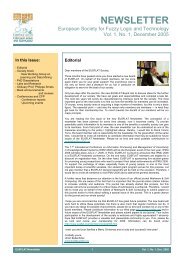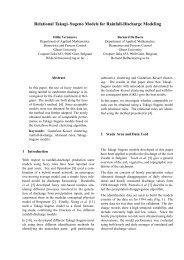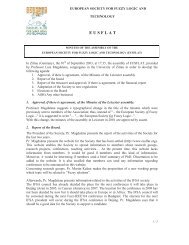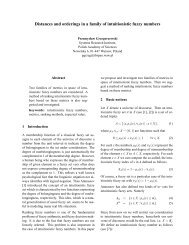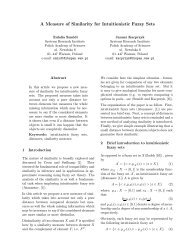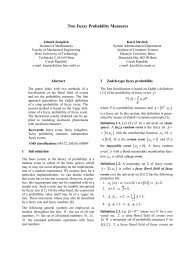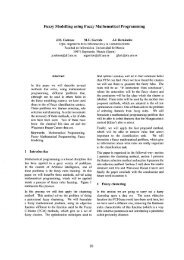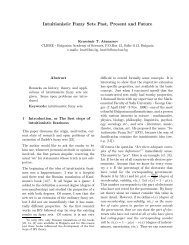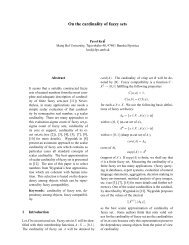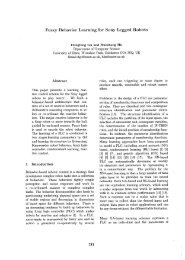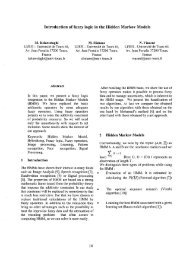Estimation of Isomorphism Degree of Fuzzy Graphs - EUSFLAT
Estimation of Isomorphism Degree of Fuzzy Graphs - EUSFLAT
Estimation of Isomorphism Degree of Fuzzy Graphs - EUSFLAT
Create successful ePaper yourself
Turn your PDF publications into a flip-book with our unique Google optimized e-Paper software.
<strong>Estimation</strong> <strong>of</strong> <strong>Isomorphism</strong> <strong>Degree</strong> <strong>of</strong> <strong>Fuzzy</strong> <strong>Graphs</strong><br />
Bershtein L.S.<br />
Department <strong>of</strong> Informatics<br />
Taganrog State University <strong>of</strong> Radioengineering<br />
Nekrasovsky Street 44<br />
347900 Taganrog, Russia<br />
Tel.: +78634383289, Fax: +78634315300<br />
e-mail: lsb@pbox.ttn.ru<br />
Abstract<br />
The questions <strong>of</strong> isomorphism degree<br />
estimation <strong>of</strong> fuzzy graphs are discussed in<br />
this paper. The definition <strong>of</strong> independent<br />
fuzzy set <strong>of</strong> fuzzy graph is presented. The<br />
estimation method <strong>of</strong> isomorphism degree<br />
<strong>of</strong> fuzzy graphs is suggested and proved.<br />
The example <strong>of</strong> isomorphism degree<br />
estimation is considered.<br />
Keywords: <strong>Fuzzy</strong> Graph, <strong>Isomorphism</strong> <strong>Degree</strong>,<br />
Independent <strong>Degree</strong>, <strong>Fuzzy</strong> Independent Vertex<br />
Set, Independent <strong>Fuzzy</strong> Set.<br />
1 Introduction<br />
A graph isomorphism search is important problem <strong>of</strong><br />
graph theory. It consists to define <strong>of</strong> bijective<br />
correspondence existence which preserve adjacent<br />
relation between vertex sets <strong>of</strong> two graphs [7]. In a<br />
case <strong>of</strong> fuzzy graphs the notion <strong>of</strong> isomorphism is<br />
fuzzy.<br />
a<br />
We consider fuzzy graphs [5]<br />
a<br />
* ; 8 and<br />
<br />
<br />
a a<br />
* < 8 , where X and Y are sets <strong>of</strong> vertices<br />
<br />
<br />
a<br />
and 8 ; ^ ¬ ; [ L [ M [ L [ M > _ [ L [ M ∈ ; ` and<br />
a<br />
<br />
8 ^ ¬ \ \ \ \ > _ \ \ ∈<<br />
` are<br />
<br />
<br />
<br />
fuzzy sets <strong>of</strong> edges with membership functions<br />
µX:X 2 →[0,1] and µY:Y 2 →[0,1]. Let numbers <strong>of</strong><br />
vertices coincide (|X|=|Y|=n).<br />
Let Φ ={F:X→Y} be a set <strong>of</strong> all bijective<br />
correspondences which may be define on the set<br />
X×Y.<br />
Bozhenyuk A.V.<br />
Department <strong>of</strong> Informatics<br />
Taganrog State University <strong>of</strong> Radioengineering<br />
Nekrasovsky Street 44<br />
347900 Taganrog, Russia<br />
Tel.: +78634310866, Fax: +78634315300<br />
avb@pbox.infotecstt.ru<br />
Definition 1 [3]. A value<br />
PD[ ¬ [ [ ↔ ¬ \ \<br />
I ; L M < L M<br />
∀)<br />
∈Φ<br />
L = Q M = Q<br />
is called an isomorphism degree <strong>of</strong> fuzzy graphs<br />
* ;<br />
a and * <<br />
a .<br />
A task <strong>of</strong> search degree isomorphism is NPcomplete<br />
task as since |Φ|=n!<br />
Here & is conjunction operation, which is defined as<br />
a&b=min{a,b}. Operation ↔ is equivalence<br />
operation, which is defined as<br />
D ↔ E = D → E E → D . Operation →<br />
is implication operation, which has property 0→b=1<br />
(falsity implies anything) [4]. In Lukasiewicz logic it<br />
is defined as D → E = PLQ^ − D + E`.<br />
Crisp graphs may be consider as fuzzy graphs which<br />
have membership functions equal 0 or 1.<br />
Consequently, their isomorphism degree f may be 0<br />
or 1 also. If f=1, then crisp graphs are isomorphous.<br />
If f=0, then crisp graphs aren’t isomorphous.<br />
Crisp graphs are defined some invariants:<br />
independent number, dominating vertex number,<br />
chromatic number and others [6]. If crisp graphs are<br />
isomorphous (f=1), then their invariants coincide. If<br />
invariants don’t coincide, then crisp graphs aren’t<br />
isomorphous (f=1)<br />
When we deal with fuzzy graphs, their invariants are<br />
fuzzy values also. A task <strong>of</strong> fuzzy invariants<br />
influence on degree isomorphism <strong>of</strong> fuzzy graphs<br />
arises in this case. A correlation between<br />
isomorphism degree and independent fuzzy sets <strong>of</strong><br />
fuzzy graphs is considered in this paper.
2 <strong>Isomorphism</strong> degree estimation<br />
Consider a fuzzy subgraph a<br />
* ;<br />
<br />
<br />
<br />
a<br />
8 <br />
, where<br />
Xi⊆X, |Xi|=k ( N = Q ).<br />
Definition 2 [1]. A value = − PD[ µ [ [<br />
α <br />
∈<br />
<br />
is called an independence degree <strong>of</strong> fuzzy subgraph<br />
* ; <br />
a<br />
.<br />
Definition 3 [1]. A subset <strong>of</strong> vertices XK⊆X <strong>of</strong> fuzzy<br />
graph * ;<br />
a is called a maximal fuzzy independent<br />
vertex set with degree α ; , if the condition<br />
; ; α α ′ < is true for all X’⊃XK.<br />
<br />
<br />
<br />
We define as α = PD[^α<br />
α α `,<br />
where<br />
<br />
<br />
<br />
<br />
<br />
<br />
<br />
<br />
α <br />
<br />
<br />
α <br />
<br />
<br />
α are the degrees <strong>of</strong> maximal fuzzy<br />
<br />
<br />
independent vertex sets, which have k elements. A<br />
PD[<br />
volume α means that fuzzy graph<br />
a a<br />
;<br />
* ; 8<br />
<br />
<br />
<br />
includes a fuzzy subgraph with k vertices and with<br />
PD[<br />
independent degree α and it doesn’t include any<br />
; <br />
subgraphs more than k vertices and with independent<br />
PD[<br />
degree more than α .<br />
; <br />
Definition 4. A fuzzy set<br />
a <br />
<br />
<br />
$ = ^<<br />
> < > < Q > `<br />
<br />
<br />
<br />
<br />
<br />
α α α is called<br />
an independent fuzzy set <strong>of</strong> fuzzy graph * <br />
a .<br />
Property 1. The following proposition is true:<br />
<br />
<br />
<br />
≥ ≥ ≥ ≥ ≥<br />
<br />
<br />
<br />
<br />
α α α .<br />
PD[<br />
Volume α equals 1 if set X doesn’t contain any<br />
; <br />
PD[<br />
vertices with loop, and volume α equals 0 if set<br />
; <br />
8 ;<br />
a contains an edge with membership function<br />
equals 1.<br />
We consider a some bijective correspondence<br />
) ; → < between vertex sets X and Y. Let f be<br />
an isomorphism degree <strong>of</strong> fuzzy graphs<br />
a a a a<br />
* ; 8 and * < 8 . Let fk be an<br />
<br />
<br />
<br />
<br />
isomorphism degree <strong>of</strong> fuzzy subgraphs<br />
a a<br />
* ; 8 and a a<br />
* < 8 .<br />
<br />
<br />
<br />
<br />
Property 2. The following proposition is true:<br />
N Q IN<br />
I ≥ = ∀ .<br />
Pro<strong>of</strong>. We renumber vertices <strong>of</strong> sets X and Y. We<br />
mark vertices <strong>of</strong> subsets XK and YK as 1,2,…,k and<br />
vertices <strong>of</strong> subsets X\XK and Y\YK as k+1, k+2,…,n.<br />
Then the degree <strong>of</strong> isomorphism may be write as:<br />
<br />
<br />
<br />
<br />
<br />
I<br />
=<br />
L=<br />
N M = N<br />
L=<br />
Q M = N + Q<br />
I<br />
N<br />
L=<br />
Q M = Q<br />
¬<br />
¬<br />
L=<br />
N + Q M = Q<br />
L=<br />
Q M = N + Q<br />
L=<br />
N + Q M = Q<br />
¬<br />
;<br />
;<br />
;<br />
¬<br />
¬<br />
[<br />
[<br />
;<br />
;<br />
[<br />
L<br />
L<br />
L<br />
[<br />
[<br />
¬<br />
[<br />
[<br />
Property 2 is proved.<br />
Property 3. Let<br />
; <br />
L<br />
;<br />
[<br />
L<br />
M<br />
M<br />
M<br />
[<br />
[<br />
[<br />
↔<br />
↔<br />
α and<br />
M<br />
L<br />
M<br />
↔<br />
[<br />
M<br />
¬<br />
¬<br />
↔<br />
↔<br />
¬<br />
<<br />
<<br />
<<br />
¬<br />
¬<br />
\<br />
\<br />
<<br />
↔<br />
degrees <strong>of</strong> fuzzy subgraphs<br />
<br />
following proposition is true:<br />
∀N = Q α ; ↔ α < ≥ I N (1)<br />
Pro<strong>of</strong>. If α and α are an independence<br />
; <br />
< <br />
degrees, then there are some vertices . ; [ [ ∈ ,<br />
for which α ; = − µ ; [ [ , and there are<br />
some \ \ ∈ < . , for which α< = − µ < \ \ .<br />
This case is presented in Figure1.<br />
<<br />
\<br />
L<br />
L<br />
L<br />
\<br />
\<br />
\<br />
¬<br />
\<br />
\<br />
L<br />
<<br />
L<br />
M<br />
M<br />
M<br />
\<br />
\<br />
\<br />
M<br />
L<br />
M<br />
\<br />
=<br />
M<br />
=<br />
≤<br />
α be an independence<br />
< <br />
* a and * < <br />
a . Then<br />
Figure 1: Example <strong>of</strong> case α = − µ [ [<br />
; <br />
and α = − µ \ \<br />
< <br />
We consider two cases.<br />
Case 1. Vertex y1 corresponds vertex x1, (F(x1)=y1),<br />
vertex y2 corresponds vertex x2 (F(x2)=y2). Then the<br />
volume I may be estimate as:<br />
I<br />
=<br />
a<br />
* ;<br />
N<br />
≤<br />
N<br />
µ<br />
−α<br />
;<br />
;<br />
<br />
<br />
[<br />
↔<br />
[<br />
− α<br />
<<br />
<br />
<<br />
↔ µ<br />
<<br />
<br />
\<br />
= α<br />
;<br />
<br />
\<br />
;<br />
=<br />
↔ α<br />
Case 2. Vertex \ corresponds vertex x1<br />
( ) [ = \ ′ ), vertex \<br />
<br />
corresponds vertex x2<br />
( ) [ = \ ′ ), but \ ′ ≠ \ and (or) \ ′ ≠ \ .<br />
<br />
<br />
; ? ; <br />
; <br />
< ? <<br />
<br />
µ [ [<br />
<br />
µ \ \<br />
[ <br />
[<br />
\<br />
\<br />
<<br />
I<br />
<br />
N<br />
< <br />
a<br />
*
Then the expression<br />
<br />
true. Hence we have <br />
−<br />
This case is presented in Figure 2.<br />
a<br />
* ;<br />
µ \ \ ≥ µ \ ′ \ ′ is<br />
<br />
W = µ \ ′ \ ′ ≥ α .<br />
<br />
<br />
Figure 2: Example <strong>of</strong> case \ ′ ≠ \ and \ ′ ≠ \<br />
We consider two cases again.<br />
Case 2.1. The following proposition is true<br />
<<br />
α ↔ α ≥ α ↔ W . Then volume<br />
;<br />
<br />
may be estimate as:<br />
I<br />
=<br />
N<br />
≤<br />
= α<br />
;<br />
N<br />
<<br />
<br />
µ<br />
−α<br />
;<br />
;<br />
N<br />
[<br />
↔α<br />
<<br />
N<br />
;<br />
[<br />
↔<br />
<br />
↔µ<br />
−W<br />
<<br />
<<br />
\ ′<br />
= α<br />
;<br />
N<br />
\ ′<br />
↔W<br />
Case 2.2. The following proposition is true<br />
α ; ↔ α < < α ; <br />
<<br />
↔ W . (2)<br />
Let vertices \ \ ∈ < correspond vertices<br />
<br />
<br />
− <br />
− <br />
[ ′ [ ′ ∈ ; , ( ) \ = [ ′ and ) \ = [ ′ ).<br />
<br />
<br />
<br />
<br />
<br />
<br />
Then µ [ [ ≥ µ [ ′ [ ′ is true and we<br />
<br />
<br />
may write<br />
<br />
W = − µ [ ′ [ ′ ≥ α . (3)<br />
<br />
Proposition (2) involves α ; ↔ α < <br />
;<br />
> W ↔ α < <br />
by condition (3). In this case volume I may be<br />
N<br />
estimate as:<br />
I ≤ µ [ ′ [ ′ ↔ µ \ \ =<br />
=<br />
µ <br />
N<br />
= W<br />
[ [<br />
;<br />
− W<br />
; ? ; <br />
[<br />
[µ<br />
[<br />
µ [ µ [ µ<br />
<br />
; <br />
[µ<br />
;<br />
;<br />
↔ α<br />
↔<br />
<<br />
<br />
< α<br />
−α<br />
;<br />
<br />
<<br />
<br />
<<br />
=<br />
↔ α<br />
< ? <<br />
<br />
The property 3 is proved for any N = Q .<br />
a <br />
<br />
<br />
Let $ = ^<<br />
> < > < Q><br />
`<br />
<br />
<br />
<br />
<br />
<br />
α α α and<br />
a <br />
<br />
<br />
$ = ^<<br />
> < > < Q > `<br />
<br />
<br />
<br />
<br />
<br />
α α α<br />
be<br />
* a<br />
independent fuzzy sets <strong>of</strong> fuzzy graphs * ;<br />
a and <<br />
\µ<br />
\<br />
<<br />
<br />
µ<br />
<br />
µ <br />
\ \ µ<br />
<br />
µ<br />
\µ<br />
<<br />
\ \ <br />
<br />
\<br />
=<br />
<<br />
=<br />
a<br />
* <br />
<br />
I<br />
N<br />
correspondingly, and f be an isomorphism degree <strong>of</strong><br />
these fuzzy graphs.<br />
Property 4. The following proposition is true:<br />
<br />
<br />
I ≤ α ↔ α . (4)<br />
<br />
<br />
= <br />
<br />
Pro<strong>of</strong>. Let a a<br />
* ; 8 and a a<br />
* < 8 be<br />
<br />
<br />
<br />
<br />
<br />
<br />
<br />
some fuzzy subgraphs with independence degrees<br />
<br />
α and <br />
<br />
<br />
α correspondingly. We consider two<br />
cases.<br />
Case 1. Subset YK corresponds to subset XK<br />
( ) ; = < ). This case is presented in Figure3.<br />
<br />
a<br />
* ;<br />
<br />
Figure 3: Example <strong>of</strong> case<br />
) ; = <<br />
I ≤ I ≤ α ↔ α on<br />
Then we can write<br />
<br />
<br />
<br />
the base <strong>of</strong> properties 2 and 3.<br />
<br />
<br />
Case 2. Subset YK doesn’t correspond to subset XK<br />
( ) ; <br />
Figure4.<br />
= < ′ ≠ < ). This case is presented in<br />
<br />
<br />
a<br />
* ;<br />
a<br />
* ; <br />
a<br />
* µ<br />
;<br />
<br />
a<br />
* ; <br />
) ; N < N<br />
) ; N < N µ<br />
µ<br />
) ; N < N<br />
Figure 4: Example <strong>of</strong> case<br />
<br />
a<br />
* <br />
<br />
a<br />
* <br />
<br />
a<br />
* µ<br />
<br />
) ; = < ′ ≠ <<br />
Then independence degree α ′ <strong>of</strong> fuzzy subgraph<br />
<br />
a a<br />
<br />
* ′ < ′ 8 ′ may be estimate as α ′ ≤ α . We<br />
<br />
<br />
<br />
<br />
<br />
<br />
<br />
also consider two cases.<br />
Case 2.1. The following proposition is true<br />
PD[ PD[ PD[<br />
α ; ↔ α<<br />
≥ α<br />
<br />
<br />
; ↔ α′<br />
< . Then<br />
<br />
isomorphism degree may be estimate as:<br />
<br />
<br />
<br />
a<br />
* <br />
a<br />
*
I ≤ I ≤ α ↔ α ≤ α ↔ α<br />
<br />
<br />
<br />
<br />
.<br />
Case 2.2. The following proposition is true<br />
PD[ PD[ PD[<br />
α ↔ α < α ↔ α ′ . (5)<br />
; <br />
<<br />
; <br />
′<br />
<br />
Let subset ; corresponds to subset <<br />
<br />
<br />
( ) ; ′ = < ). Let α ′ be an independence degree<br />
<br />
′<br />
<br />
<br />
<strong>of</strong> subset ; <br />
. Then we write<br />
α ′ <br />
<br />
≤ α . (6)<br />
<br />
Proposition (5) involves inequality<br />
PD[<br />
α ; <br />
PD[<br />
↔ α < < α ′ ; <br />
PD[<br />
↔ α < <br />
by condition (6).<br />
In this case isomorphism degree may be estimate as:<br />
I ≤ I ≤ α ′ <br />
<br />
<br />
<br />
↔ α ≤ α ↔ α .<br />
<br />
<br />
<br />
Property 4 is proved because we consider all cases.<br />
Example. Estimate <strong>of</strong> isomorphism degree <strong>of</strong> the<br />
fuzzy graphs, shown in the Figure 5.<br />
[ [<br />
\<br />
[ \<br />
[ \<br />
Figure 5: Example <strong>of</strong> fuzzy graphs<br />
′<br />
<<br />
<br />
* <br />
a and<br />
Independent fuzzy sets <strong>of</strong> these fuzzy graphs are<br />
a<br />
defined as $ = ^<<br />
> < > < > < > `<br />
<br />
and<br />
a<br />
$ = ^<<br />
> < > < > < > `.<br />
<br />
Then isomorphism degree is estimated as:<br />
PD[ PD[<br />
I α ↔ α =<br />
≤<br />
N =<br />
= PLQ<br />
;<br />
↔<br />
<br />
↔<br />
↔<br />
↔ =<br />
Hence, we may assert that isomorphism degree <strong>of</strong><br />
these fuzzy graphs will not be larger then 0,8.<br />
3 Conclusion<br />
Proven proposition (4) allows estimate a possible<br />
isomorphism degree <strong>of</strong> fuzzy graphs by fuzzy<br />
independent sets. It is necessary to remark that the<br />
estimate <strong>of</strong> isomorphism degree may be receive by<br />
another invariants <strong>of</strong> fuzzy graphs, such as<br />
dominating vertex sets, fuzzy graph kernels [1],<br />
fuzzy chromatic set [2].<br />
<<br />
<br />
* a<br />
<br />
\<br />
References<br />
[1] L. Bershtein, A. Bozhenuk (2001). Maghout<br />
Method for Determination <strong>of</strong> <strong>Fuzzy</strong> Independent,<br />
Dominating Vertex Sets and <strong>Fuzzy</strong> Graph Kernels.<br />
In Int. J. General Systems, volume 30, ‹1, pages<br />
45-52.<br />
[2] L. Bershtein and A. Bozhenuk (2001). A KRORU<br />
Problem for <strong>Fuzzy</strong> Graph. In Proceedings <strong>of</strong> the<br />
international conference 7 th <strong>Fuzzy</strong> Days, volume<br />
2206, pages 500-505 Dortmund, Germany, October<br />
1-3, 2001.<br />
[3] L. Bershtein, V. Karelin, A. Tcelych (1999).<br />
Models and Methods <strong>of</strong> Decision Making in<br />
Intelligence Systems. Rostov-on-Don State<br />
University, Russia.<br />
[4] D. Dubois, H. Prade (1999). <strong>Fuzzy</strong> Sets in<br />
Approximate Reasoning, Part 1: Inference With<br />
Possibility Distributions. In <strong>Fuzzy</strong> Sets and Systems,<br />
‹ SDJHV<br />
[5] A. Kaufmann (1977). Introduction a la theorie<br />
des sous-ensemles flous, Masson, Paris, France.<br />
[6] A. Kaufmann. (1968). Introduction a la<br />
combinatorique en vue des applications, Dunod,<br />
Paris, France.<br />
[7] A. Zykov (1987). Graph Theory Base. Moscow,<br />
Nayka.



